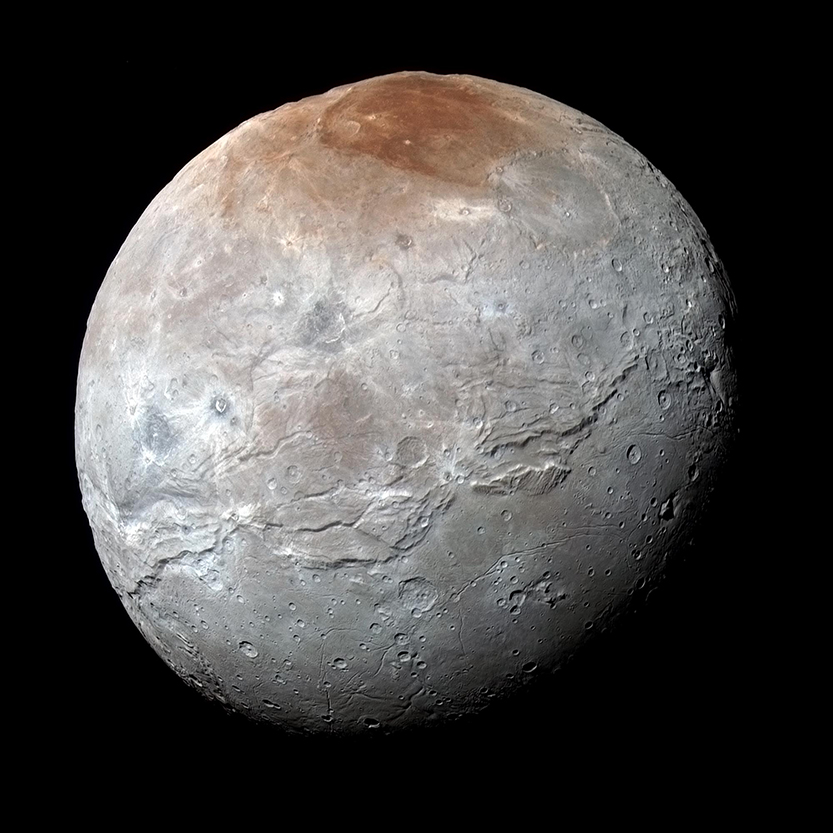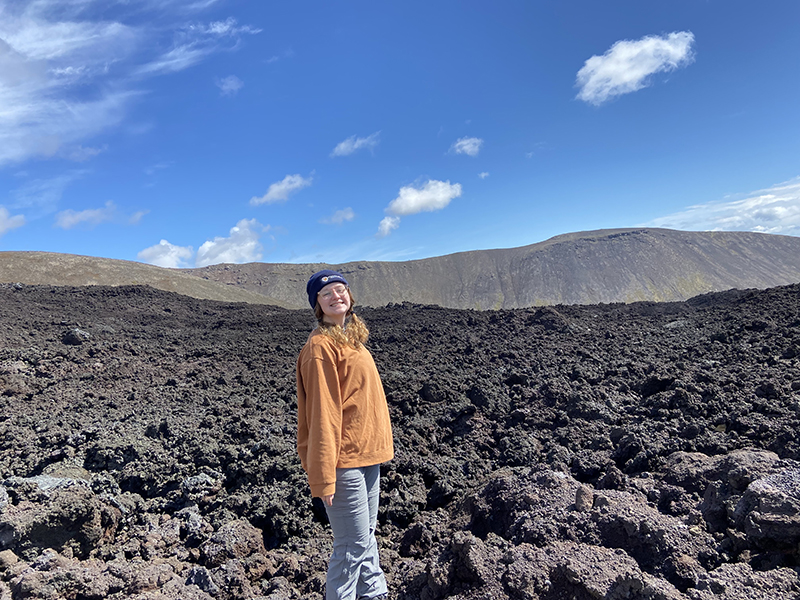Blushing moon could reveal secrets of planetary bodies and their red-colored regions
08-10-2022

The Kuiper Belt is a massive region of icy planetary bodies that exists on the outermost parts of our solar system that has largely been unexplored. The most notable body in this belt is Pluto. Many of the objects in the Kuiper Belt have red regions on their surfaces. Pluto’s largest moon, Charon, is one such object that boasts of this blush. The NASA mission New Horizons spacecraft returned high resolution images of Charon and allowed planetary scientists to further study this red phenomenon. Researchers at the Purdue University Department of Earth, Atmospheric, and Planetary Sciences (EAPS) studied this data and performed geological analysis and modeling that determines that cryovolcanism is quite possibly cause of these massive red polar spots. They published their findings in Nature Communications on August 9, 2022.
The team of includes Ms. Stephanie Menten, EAPS PhD student, Dr. Mike Sori, EAPS Assistant Professor, and Dr. Ali Bramson, EAPS Assistant Professor. The team proposes that this red coating actually came from within Charon due to cryovolcanism. At one point in Charon’s past, it experienced a large episode of cryovolcanism that ended up resurfacing a lot of the southern part of the moon. Cryovolcanism is volcanism where the ‘lava’ is a mixture of water, ice, and other material instead of molten rock.
“In our work, we predict that this episode of cryovolcanism probably released some methane gas onto Charon’s surface, similar to how large eruptions on Earth release carbon dioxide or other gases,” explains Menten. “We estimated exactly how much methane this eruption could have released through looking at geologic features on Charon’s surface and estimating the overall volume of the cryovolcanic eruption, and then used modeling to determine exactly what happened to this methane after it made it to Charon’s surface. We found that most methane would end up migrating to Charon’s poles, where the temperature is then cold enough for this methane to stay in place as ice and get processed by radiation, creating the red-colored north pole that we observe in images. This is really important when we think about the other large objects we know of in the Kuiper belt, which also have red surfaces that could be the result of cryovolcanism similar to what we propose on Charon.”
Video produced from the NASA mission New Horizons provided stunning detail of Pluto and it's largest moon, Charon. At about 36 seconds into this video, the red region of Charon can be seen. Video by NASA.
Much of this research involved modeling. The team set out to simulate how methane moves across Charon’s surface in order to determine how much of it would end up at the poles. The extreme cold at the poles traps the methane so that it can no longer keep moving. Menten used the programming language MATLAB to create a model that tracks methane molecules as they move across the surface of Charon. The team used geological mapping data received from NASA’s New Horizons mission, which is the first mission to visit the Kuiper Belt. So far, the only large objects in the Kuiper Belt to have been visited by spacecraft are Pluto and Charon so little is known about these outermost elements of our solar system.
“What we do know about these other objects in the Kuiper Belt comes from Earth-based telescope observations,” says Menten. “Many of these dwarf planets are red and have methane detected on their surfaces from what we observe here on Earth. We propose that cryovolcanism is a potential source that provides methane to KBO surfaces from their interiors. Overall, cryovolcanism could be a very important process that occurs frequently on large objects in the Kuiper belt, which would be really exciting!”
The next steps in this research involve steps that had to occur earlier in the process of cryovolcanism. This publication focused on the last step in the process - the release of atmospheric gases after cryovolcanic eruptions occur. Menten plans to further her research with the earlier stages, like how the cryolava erupts onto the surface of Charon in the first place. There is some additional potential future work regarding the modeling of how the actual cryoflow released its volatiles.

Menten received her bachelor’s degree from North Carolina State and arrived at Purdue University in 2020. Her research interests involve terrestrial (rocky) volcanism and cryovolcanism (icy volcanism).
“Growing up, I was always really fascinated by volcanoes and how they worked,” she says. “Learning about volcanism happening on other planets and how there are people that study it made it clear to me that this was the career path I should choose!”
About the Department of Earth, Atmospheric, and Planetary Sciences at Purdue University
The Department of Earth, Atmospheric, and Planetary Sciences (EAPS) combines four of Purdue’s most interdisciplinary programs: Geology & Geophysics, Environmental Sciences, Atmospheric Sciences, and Planetary Sciences. EAPS conducts world-class research in the Earth and Planetary sciences, educates undergraduate and graduate students, and provides our college, university, state and country with the information necessary to understand the world and universe around us. Our research is globally recognized, our students are highly valued by graduate schools, employers, and our alumni continue to make significant contributions in academia, industry, and federal and state government.
Writer: Cheryl Pierce